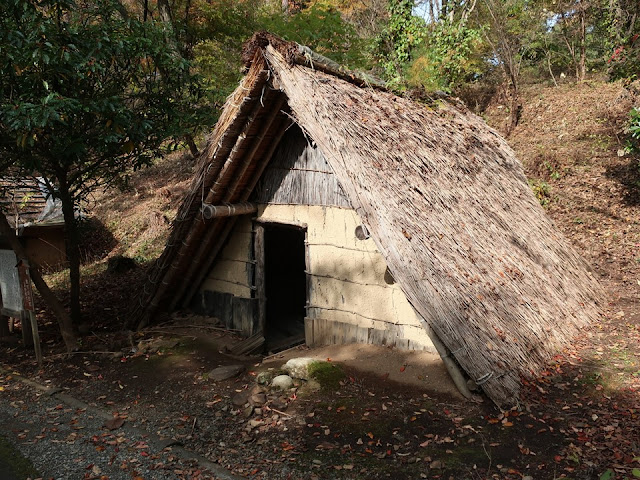Old houses of Morioka prefecture are
preserved in the site. It is a peaceful and
nostalgic landscape. I feel someone lives even now when I saw floor cushions
(zabuton) around an “irori” fireplace. It’s a good display.
Not only residences but also huts are in
the village which help us to understand old lives. Moreover, the houses in the
ancient period were rebuilt here.
There was a feudal rule about houses. The
pillars of a samurai’s house are made of Japanese cedar. On the other hand, the
ones of farmer’s houses are made of chestnut tree which doesn't look good but
is strong. In addition, there is no ceiling in the farmer’s houses.
The volunteer guide showed me around for an
hour, so I could understand how people lived well.
北上川周辺の家屋を保存する民俗村は、のどかでした。いわゆる原風景ですね。
でも、武士の家は、杉材で造られ天井があり、農家は、栗材(強いが曲がりが多い)で天井なし、商人の家は、天井だけでなく書院もあって良い造り。身分に応じたルール、封建制の縛りを感じました。囲炉裏の周りに藁布団があったり、今も人が住んでいる感じがする保存の仕方です。
ボランティアガイドの方が、一時間をかけて村を説明してくださり、いろいろな階層の人々の暮らしを理解できました。移築した民家だけでなく、作業小屋や室町時代以前の家が再現されていて、中世の人々の住まいもわかります。
Farmer’s houses、農家
Former Onodera family residence; there is an earthen floor inside the entrance on the right. A horse also lived there.
八幡平市にあった旧小野寺家住宅。右側の入口の先は土間で、馬屋もあります。
The house is very large. Although farmers were not permitted to use Japanese cedar, they used thick and good chestnut wood as pillars and beams. We can walk on the wooden floor, and we can hear the explanation about the house and the life, which was recorded by an elder woman. It is as if she emerges from the far side of the room.
中は広いですねえ。農家は杉を使うことは許されませんでしたが、立派な栗材を使っています。家に上がれます。ボタンを押すと、音声が流れ、おばあさんが家や暮らしを説明してくれます。生活感が残っていて、奥から「よく来たねえ」とおばあさんが出てきそうな感じがしました。
The house above is called “magari (bent) – ya (house)”. A horse lived in the protruding section. K. Yanagida visited this house when it was in Tono area. He was the most famous folklorist and wrote “Tono monogatari” which English edition “The Legends of Tono“ is sold as a Kindle book.
遠野の曲り屋。旧北川家には柳田國男や折口信夫も訪れました。曲がったところが馬屋です。
Kitagawa family who owned the house was a kind of a local agent of the mountain worship “Haguro Shugen”, therefore there is an altar room in the house.
Reference (Haguro Shugen): https://hagurokanko.jp/en/341-yamabushisyugyou/hagurosyugendou/
Btw, there is no ceiling even in this room. It was not allowed to install ceilings because farmers hid rice. I heard it at the farmhouse of Konnos in Tohoku History Museum.
北川家は代々、羽黒山への修験者をとりまとめる羽黒修験で祭壇があります。でも、この部屋にも天井はありませんね。天井裏は、米を隠す場所になるので、伊達藩では農家が天井を貼ることを禁じたという例があります(東北歴史博物館の今野家)。
This house was in a heavy snowy area, so wooden sleds are kept at the entrance.
豪雪地帯の住宅の前には、木のソリを立てられています。(西和賀町の旧菅原家)
A tobacco grower possessed this house. It is well-ventilated in order to dry leaves. Japanese farmhouses equip a working space usually.
たばこ農家の旧佐々木家では、家の中でたばこの葉を干していますよ。風通しが良い構造にしています。農家は作業場込みですね。
Hut and Storage、作業小屋と保管庫
The charcoal hut was rebuilt. There are many sites which displayed old houses, however, it is rare to show us a non-residence. About thirty thousand people in Iwate prefecture were engaged in making charcoal in the mid-twenty century. It was before the coal spread widely.
炭焼き小屋。石炭が普及する前の昭和30年頃には、岩手県内に三万人の生産者がいたそうです。復元した建屋ですが、住居以外があるのは珍しいと思います。
The villagers kept funeral equipment in this hut. It was the time that an interment was common. Each village had the hut; they segregated the equipment from daily utensils.
がん小屋。何だと思いますか。葬式の道具を納めておく小屋です。土葬が一般的だった時代で、各集落に一戸は建てられ、共同で利用されていました。普段の生活道具と区別したのですね。
Samurai’s residence、武士の家
A middle-class samurai lived in this house. A step in a Japanese entryway is called “Shiki-dai(step)”. Only samurai was permitted to make it.
伊達藩の浮牛城(ふぎゅうじょう)は、南部藩との境にありました。その城代家老を務めた大泉氏(50石)の住宅です。式台は武家に許された仕様です。
In front of a “zashiki” guest room which has a tatami floor mat, there is a living room with a wooden floor. Their lives were not flashy.
座敷の手前に囲炉裏がある板の間があり、「常居」と書かれていました。城代家老が板の間、違和感はありますが、親近感を持てます。
Houses in the ancient and the medieval era、古代・中世の家
A potter's wheel was used in the house.
家の中にろくろがあったそうです。
A house in around the mid-14th century was rebuilt. A cuboid type emerged instead of a cone type.
室町時代の竪穴式建物。北上市鬼柳町で発掘された650年前の建物の復元です。矩形で土壁なのが特徴ですね。
It was a still pit-dwelling. I hope the family had led a warm time although it is poor interior.
でも、家の中は、竪穴です。あばら屋ですが、家族が入ると温かかったでしょうねえ。
A house before several thousand years was under renovation.
縄文時代の家は、修復中でした。
The nostalgic scenery relaxed me while walking in the village.
村の中の道を歩いていると、ホッとします。
Official website: http://michinoku-fv.net/ (in Japanese), accessed in August, 2021
Kitakami City Museum、北上市立博物館
The village belonged to the city museum which is in the same site. It introduces the history of Kitakami city mainly.
みちのく民俗村や民俗資料館は、元々は博物館の付属施設でした。今は管理が別になっていますが、博物館は、村の隣にあり、主に歴史を紹介しています。
In this area, Kunimi-yama ruined temple is introduced. It prospered around a thousand years ago.
国見山廃寺。千年前、北上盆地の中心寺院として栄えたお寺です。
Water transportation of Kitakami River which is the fifth longest one in Japan also prospered before the modernization.
北上川の舟運。舟で運ぶと、楽です、何と言っても。
In order to go upstream, people had to pull a ship if there was no wind. The ship was rebuilt and the job was reenacted in 1987.
北上川河口の石巻から戻ってくる時は、風が無ければ人力の曳き舟でした。(復元船の曳き舟、1987)
Reference(参照): exhibits
about folklore are exhibited in the Folklore Museum、民俗関係の展示は民俗資料館にあります。
Folklore Museum in Michinoku Folklore Village、みちのく民俗村・民俗資料館
Official
website: https://www.city.kitakami.iwate.jp/life/kurashi_tetsuduki/bunka_sports/bunkashisetsu/3/index.html
(in Japanese), accessed in August, 2021
Visited in November, 2020
Previous post (Folklore museum at the same site):
Folklore Museum in Michinoku Folklore Village、みちのく民俗村・民俗資料館
Next post (Museum
about “Oni” and the local festival in the same city):






















Comments
Post a Comment